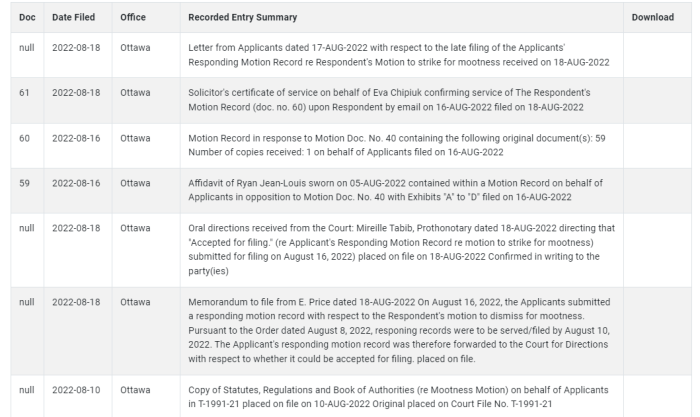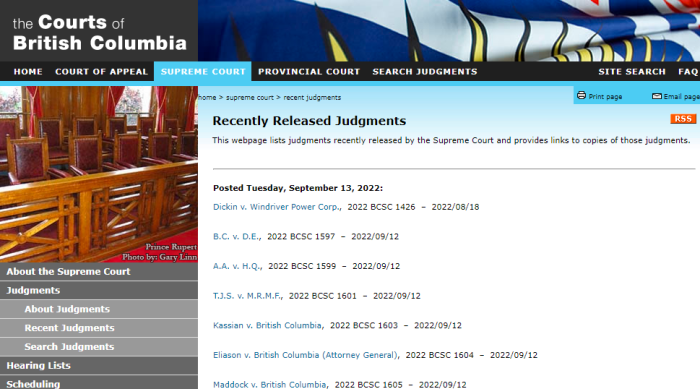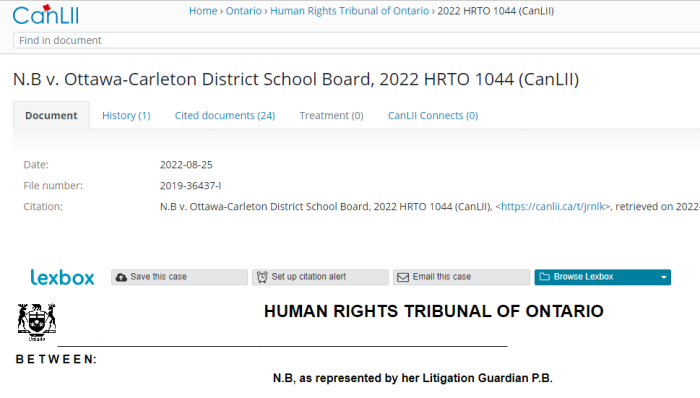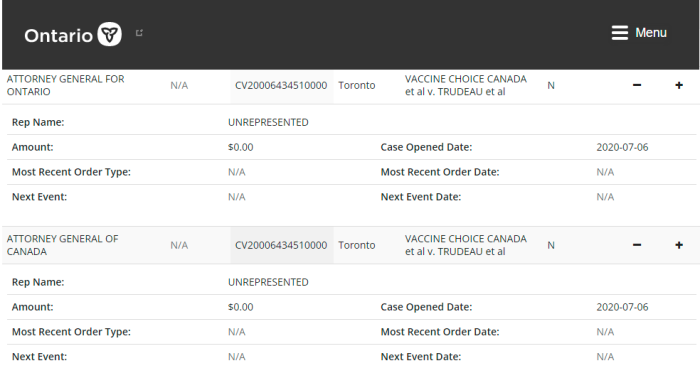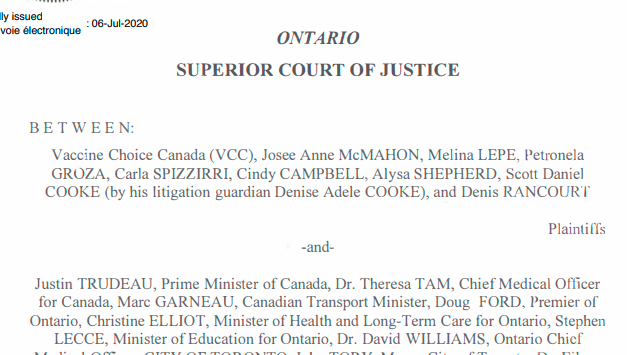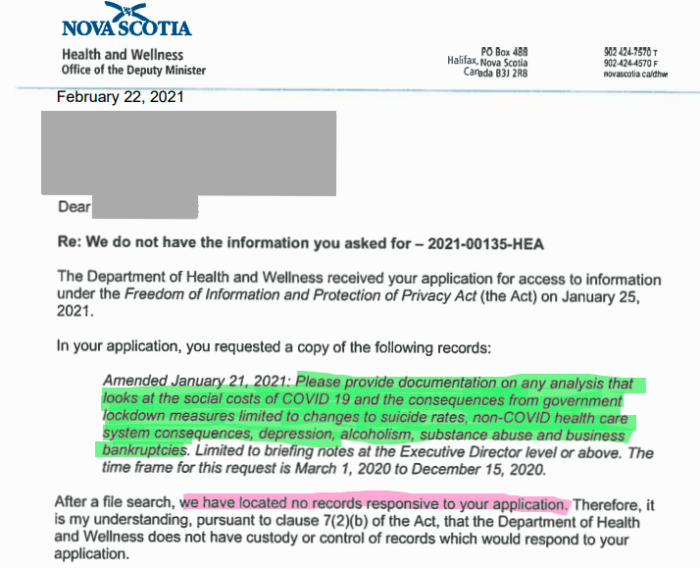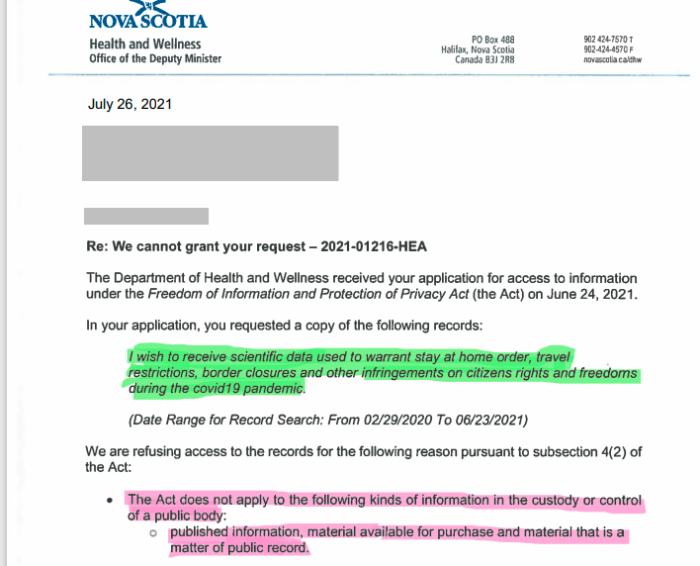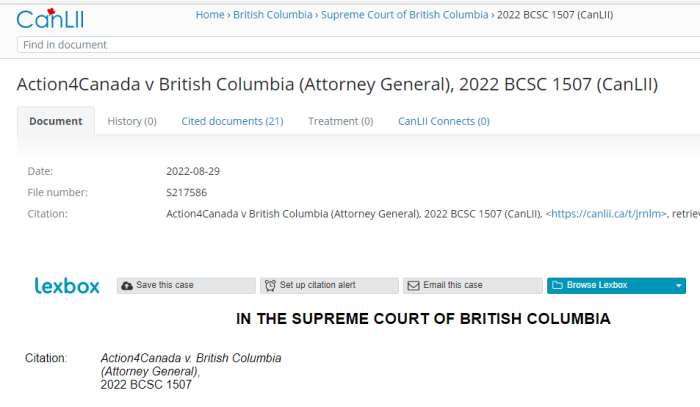
In a decision that was long anticipated, Action4Canada’s 391 page Notice of Civil Claim against lockdown measures has been struck in its entirety.
It was predicted on this site a full year ago that this Claim would go absolutely nowhere. In fact, a detailed outline of the defects was published.
One difference however, is that this Judge is allowing the NOCC to be rewritten, if the Plaintiffs are willing to. Given the length of it, that will be no easy task.
The ruling from Justice Ross outlines just how poorly drafted the suit was. It failed to even meet the bare minimum for a case to go ahead. Keep in mind, at this stage, Judges are required to accept allegations as fact (for argument’s sake), and just look at the pleadings. The ruling is to the point, and doesn’t really need much in the way of commentary, or explanation.
For reference: NOCC means Notice of Civil Claim.
[20] The description of “THE FACTS” in the NOCC comprises 316 paragraphs set out over 226 pages. This section of the NOCC also includes 399 footnotes, the majority of which contain links to websites.
[21] I note, for the clarity of anyone reading the pleadings, that the numbering of the paragraphs in the NOCC leads to further confusion. First, there are two paragraphs numbered “12”. More problematic, the paragraphs proceed from 1-331 followed, for no reason, by paragraphs 255-363. As a result, the section labelled “THE FACTS” appears to comprise only 240 paragraphs (44-284), when it actually consists of 316 paragraphs. It follows that the reader must be careful to address either the first, or the second, paragraph 255 etc. I return to this issue below when discussing the second paragraph 289
This is a (somewhat minor) point, but good for a chuckle. The paragraphs in the NOCC weren’t numbered correctly or consistently, making it unclear what was being referenced at times.
[22] The “RELIEF SOUGHT” section of the NOCC comprises 40 paragraphs, most with multiple subparagraphs, set out over 43 pages.
This is absurd to the point of comedy. It takes 43 pages for the Plaintiffs to spell out the relief, or what they are asking the Court to grant.
[35] The defendants submit that, more important than the length of the NOCC is the unlimited scope of the document. It is not a piece of legal drafting that complies with the Rules, or basic tenets, of pleading. It is not a document that can be properly answered in a response to civil claim. The defendants submit that those problems arise, in part, because there are multiple allegations against the defendants individually and jointly. It would be extremely difficult, if not impossible, for any individual defendant to determine whether it is required to respond to any particular allegation. Were the action to proceed in its current form, individual defendants would not be in a position to know whether they were tasked with a burden of disproving or countering the myriad allegations. They would not know what case they were required to meet.
Where are they wrong? The NOCC is written in such a way that it’s pretty much impossible to know exactly what the allegations are to be addressed. This can’t be dealt with in any meaningful way.
[45] On the first issue, whether the NOCC is prolix, I agree with the defendants’ submission: the NOCC, in its current form, is not a pleading that can properly be answered by a responsive pleading. It describes wide-ranging global conspiracies that may, or may not, have influenced either the federal or the provincial governments. It seeks rulings of the court on issues of science. In addition, it includes improper allegations, including criminal conduct and “crimes against humanity”. In my opinion, it is “bad beyond argument”.
[46] I further find that it is not a document that the court can mend by striking portions. I find that this NOCC is analogous to the Statement of Claim considered by Justice K. Smith (as he then was) in Homalco Indian Band v. British Columbia (1998), 1998 CanLII 6658 (BC SC), 25 C.P.C. (4th) 107 (B.C.S.C.) [Homalco]. He wrote:
.
[11] In my view, the statement of claim is an embarrassing pleading. It contains much that appears to be unnecessary. As well, it is constructed in a manner calculated to confuse the defendants and to make it extremely difficult, if not impossible, to answer. As a result, it is prejudicial. Any attempt to reform it by striking out portions and by amending other portions is likely to result in more confusion as to the real issues.
The Judge concludes that it’s far more than just errors or inconsistencies in this pleading. The NOCC was written in such a manner that it’s impossible to properly respond to. In other words, while there may be a case for the Plaintiffs, and the Defendants are justified in attempting to strike it.
Moreover, the document is horrible through its entirety. This isn’t an instance where a few bad paragraphs or pages can be removed. These defects plague the entire paper. That’s right, it’s not worth saving, at least not in its current form.
[51] To put those points another way, I have indicated above that the prolix nature of the NOCC makes it impossible for the defendants to respond to it. For the same reason, I am not able to parse the 391 pages of the improperly drafted NOCC and indicate whether paragraphs, categories or claims should remain in, or should be struck. That is not the proper role of this court. It is counsel’s obligation to draft pleadings that do not offend the mandatory requirements of the Rules.
[52] The defendants submit that the NOCC pleads to a number of claims that are improper in a civil action. In part, the defendants point to the following elements of the NOCC as inappropriate:
.
a) alleging criminal conduct;
b) seeking a declaration that the preponderance of the scientific community is of the view that masks are ineffective in preventing transmission;
c) seeking a declaration that the motive and execution of the COVID-19 prevention measures by the World Health Organization are not related to a bona fide “pandemic”;
d) seeking a declaration that administering medical treatment without informed consent constitutes experimental medical treatment which is contrary to the Nuremberg Code, the Helsinki Declaration and is a crime against humanity under the Criminal Code of Canada;
e) seeking a declaration that the unjustified, irrational, and arbitrary decisions of which businesses would remain open, and which would close, as being “essential”, or not, was designed and implemented to favour mega-corporations and to de facto put most small businesses out of business; and
f) seeking a declaration that the measures of masking, social distancing, PCR testing, and lockdowns are not scientifically based, and are based on a false and fraudulent use of the PCR test.
[53] I agree with the defendants that these are improper claims.
Quite simply: this does not belong in a civil claim. It’s mind boggling to think that the lawyers who (allegedly) wrote this have a combined 70 years of experience between them. Seriously, how is a civil court — even with a very experienced Judge — supposed to rule on such things?
And where exactly is Lawrence Wong anyway?
Summary and Conclusion
[74] In summary:
a) I find that the NOCC, in its current form, is prolix and must be struck in its entirety;
b) I grant the plaintiffs liberty to amend the NOCC; and
c) This action is stayed pending the filing of a fresh pleading.
[75] On the issue of costs, I note that each plaintiff is pursuing this action seeking money damages from one or more defendant. In responding to those claims each defendant has been put to the expense of answering (if not filing a response) to the NOCC. In addition, the defendants have all been required to prepare for and conduct this application. None of those steps would have been necessary if the matter was properly pleaded.
[76] On that basis, I find it appropriate to award each defendant the costs for the necessary steps of “defending a proceeding”, and for preparing for and attending an application (opposed). Those costs are payable forthwith in any event of the cause.
Do read the entire decision. It’s very revealing.
The part of the decision that came as a surprise was that the Judge allowed for the NOCC to be rewritten. More on that in a bit. There were sections worth salvaging, and that allowed some reprieve.
However, this forces the next decision onto the Plaintiffs. Do they undertake the massive effort needed to make almost 400 pages compatible with the B.C. Rules of Civil Procedure? Or do they simply walk away with this?
In any event, very steep costs are almost a given at this point. This is something the individual Plaintiffs were likely not fully aware of. If a case like this is thrown out, they’re on the hook for at least some of the costs that would be ordered.
According to the Western Standard, Tanya Gaw, the head of Action4Canada, was asked if individual Plaintiffs would be indemnified against such an order. In essence, would the organization ensure no one was stuck with a huge bill? The refusal to give a definitive answer was not encouraging.
It was admitted in the May 31, 2022 hearing that over $750,000 had been raised for this lawsuit. In the interests of fairness, protecting the individual Plaintiffs should be a no-brainer.
That said, the Court declined to completely throw the case out.
[59] The defendants urge upon me that the problems with the NOCC are sufficient grounds for me to conclude that this entire action is an abuse of process and should be dismissed on the basis that it is clearly frivolous and vexatious.
[60] I do not accept that submission on behalf of the defendants. For the reasons set out below, I decline to dismiss the action.
Yes, the pleadings were horrible, but that didn’t make the issues themselves frivolous.
The next several paragraphs go on to outline serious concerns including Charter protections and due process. In other words, there were legitimate issues raised. However, this NOCC was such a mess that it was impossible to sort out the issues in any reasonable manner.
[71] Put simply, individuals have standing to question whether state actions infringe their Charter protected rights. Hence, in this case, there is a prospect that the plaintiffs could put forward a valid claim that certain of the COVID-based health restrictions instituted by the Federal or Provincial governments infringed their Charter rights. In addition, it is possible that other valid claims may exist. It will be for the plaintiff to plead those causes of action in accordance with the Rules. Such claims need to be framed in a manner that is intelligible and allows the defendants to know the case they have to meet. It must also confine itself to matters that are capable of adjudication by this court and relief this court is capable of granting.
Yes, there are issues that are worth looking into. However, the NOCC needs to be drafted properly, and not like it has been done here. It came down to the quality and organization of the pleadings themselves, not necessarily the topics that to be examined.
Will the 400 page NOCC be fixed up and refiled — as time consuming as that will be — or is this the end of the road for the Action4Canada case? Even though a rewrite is allowed, this likely won’t sit well with many. Had it been properly written in the first place, it may very well have survived intact.
We’ll have to see what happens next, but what a waste of time, energy and money.
Another prediction: the next one to get challenged will be the July 6, 2020 case with Vaccine Choice Canada. The Ontario Attorney General can now use this ruling.
DECISION
(1) https://www.canlii.org/en/bc/bcsc/doc/2022/2022bcsc1507/2022bcsc1507.html
(2) https://www.canlii.org/en/bc/bcsc/doc/2022/2022bcsc1507/2022bcsc1507.pdf
(3) https://www.bccourts.ca/jdb-txt/sc/22/15/2022BCSC1507.htm
(4) https://www.westernstandard.news/bc/bcs-unvaccinated-doctors-want-to-get-back-to-work-and-they-hope-a-billboard-helps/article_6ac058b4-24e1-11ed-9d74-67b04bfc88ce.html
ACTION4CANADA BCSC DOCUMENTS:
(1) A4C BCSC – Notice Of Civil Claim
(2) A4C BCSC – Response to Civil Claim (Health Authority Defendants)
(3) A4C BCSC – Response to Civil Claim (Provincial Defendants)
(4) A4C BCSC – Affidavit No 1 of Rebecca Hill
(5) A4C BCSC – Notice of Application (AG and RCMP applies to strike)
(6) A4C BCSC – Notice of Application (Provincial Defendants applies to strike)
(7) A4C BCSC – Notice of Application (Translink applies to strike)
(8) A4C BCSC – Application Response (Health Authority Defendants consent to strike)
(9) A4C BCSC – Application Response (BC Ferries consents to strike)
(10) A4C BCSC – Application Response (AG and RCMP consent to Prov. strike application)
(11) A4C BCSC – Application Response (Translink consents to HA Defendants strike application)
(12) A4C BCSC – Application Response (Translink consents to Prov. strike application)
(13) A4C BCSC – Affidavit No 2 of Rebecca Hill
(14) A4C BCSC – Application Record (to strike)
(15) A4C BCSC – Application Response (all plaintiffs)
(16) A4C BCSC – Amended Application Response (all plaintiffs)
(17) A4C BCSC – Reasons For Striking NOCC In Its Entirety
(18) A4C BCSC – Order striking pleadings
(19) A4C BCSC – Order striking pleading in its entirety with costs payable forthwith
(20) A4C BCSC – Appointment to assess bill of costs for Kwok and Translink
(21) A4C BCSC – Notice of Discontinuance (Kimberly Woolman & Estate of Jaqueline Woolman)
(22) A4C BCSC – Notice of Discontinuance (Amy Muranetz)
(23) A4C BCSC – Notice of Discontinuance (Federico Fuoco & Fire Productions Ltd.)
Like this:
Like Loading...
